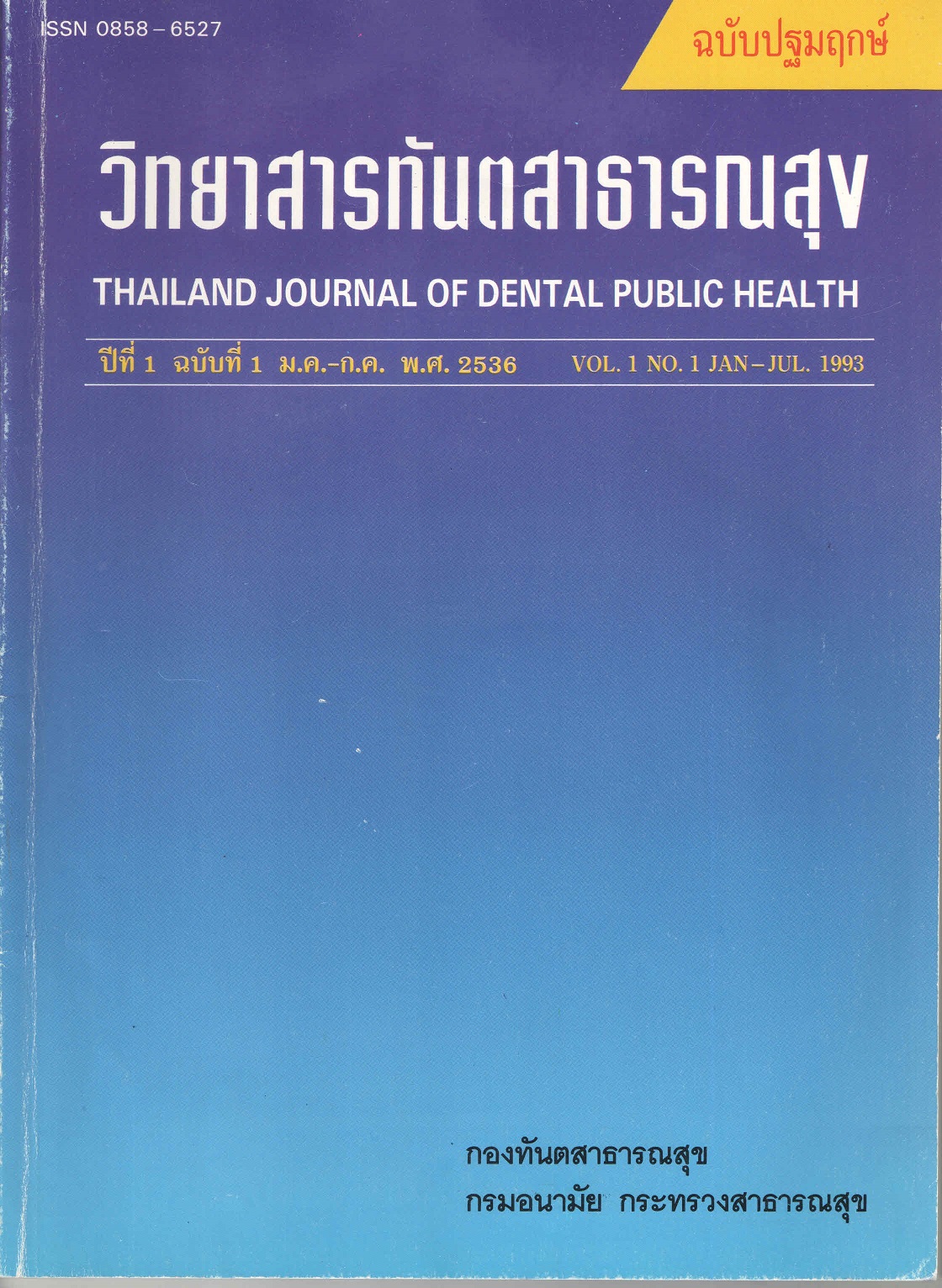การวิเคราะห์ปริมาณฟลูออไรด์ในน้ำชาบางชนิดในประเทศไทย
Main Article Content
Abstract
ได้ทําการวิเคราะห์หาปริมาณฟลูออไรด์ในน้ําชาจากใบชา 33 ชนิด ชาซอง 7 ชนิด และชาผง สําเร็จรูป 3 ชนิด โดยใช้วิธี Ion selective electrode และเลือกเวลาของการแพร่ละลาย 5 นาที เพื่อ ใช้แนะนําให้เป็นทางเลือกอีกทางในการให้ฟลูออไรด์เสริมในเด็กนักเรียนวัยประถมศึกษา (อายุ 6-13 ปี) และในผู้ใหญ่ที่ฟันยังขึ้นไม่ครบ ผลปรากฏว่า ใบชาทั้ง 3.3 ชนิด, ชาซอง 7 ชนิด และชาผงสําเร็จรูป 3 ชนิด มีปริมาณฟลูออไรด์โดยเฉลี่ย 0.20-1.22, 0.68-1.80, 0.76-1.44 ส่วนในล้านส่วนตามลําดับ และมีปริมาณฟลูออไรด์สูงสุดซึ่งสามารถละลายได้ในน้ําโดยเฉลี่ย 0.58-2.12 ส่วนในล้านส่วนในใบชา 1.22-2.32 ส่วนในล้านส่วนในชาซอง สําหรับชาผงสําเร็จรูปละลายได้หมด
Downloads
Download data is not yet available.
Article Details
How to Cite
1.
รัตนธรรม ก. การวิเคราะห์ปริมาณฟลูออไรด์ในน้ำชาบางชนิดในประเทศไทย. Th Dent PH J [Internet]. 1993 Jul. 30 [cited 2025 Jan. 15];1(1):50-7. Available from: https://he02.tci-thaijo.org/index.php/ThDPHJo/article/view/215070
Section
Original Article
References
1. J.R. Smid, and B.J. Kruger., "The Flouoride content of some teas available in Australia' Australian Dental Journal, February. 1985. Vol 30. No. 1 pp. 25 - 28
2. Jamie Shelleck., "Tea'' 1st ed, The Viking Press Ino, New York, 1972.
3. คณะทันตแพทยศาสตร์ จุฬาลงกรณ์มหาวิทยาลัยและกองทันตสาธารณสุข กรมอนามัย กระทรวง สาธารณสุข “การสัมมนาทางวิชาการทันต สาธารณสุข เรื่องฟลูออไรด์และสารควบคุมแผ่น คราบจุลินทรีย์ในงานทันตสาธารณสุข” 19-20มีนาคม 2527, 1.07-1.16
4. วิทิต วัฒนาวิบูล “ชา กินเป็นยา” วารสารหมอชาวบ้าน ปีที่ 7, ฉบับที่ 74, หน้า 49-50.
5. ธรพันธ์ “เครื่องดื่มมหัศจรรย์” วารสารทักษะ
ฉบับที่ 40, เดือนสิงหาคม 2525, หน้า 59-60
6. ปาริชาติ บุญทิคำ. “ก้าวไปกับอาหารและโภชนาการ”. โภชนาการสาร, ปีที่ 21 ฉบับที่ 4. ตุลาคม-ธันวาคม 2530, หน้า 257-258.
7. Encyclopedia Britannica Vol. 21, Encyclopedia Britanice, Inc. William Benton, Publisher, U.S.A., 1969.
8. C.R., Harler., "The Culture and Marketing of Tea" 3rd ed, Oxford University press, London, 1964.
9. T. Eden, "TEA" 1st ed, Longmans,London, 1958.
10. R.L.speirs., "Correlations between the concentrations fo fluoride and some other constituents in tea infusions and their possible dental caries - preventive effectW Archs oral Biol, 1983, Vol. 28, No. 6, pp. 471-475E SUD
11. M. Nierenstein., "Natural organic tannins'' 1st ed, J & A Churchill Ltd, London, T 1934 12. John W. Rowe, "Natural Products of a Woody Plants !" Springer-Verlage, London, 1989.
2. Jamie Shelleck., "Tea'' 1st ed, The Viking Press Ino, New York, 1972.
3. คณะทันตแพทยศาสตร์ จุฬาลงกรณ์มหาวิทยาลัยและกองทันตสาธารณสุข กรมอนามัย กระทรวง สาธารณสุข “การสัมมนาทางวิชาการทันต สาธารณสุข เรื่องฟลูออไรด์และสารควบคุมแผ่น คราบจุลินทรีย์ในงานทันตสาธารณสุข” 19-20มีนาคม 2527, 1.07-1.16
4. วิทิต วัฒนาวิบูล “ชา กินเป็นยา” วารสารหมอชาวบ้าน ปีที่ 7, ฉบับที่ 74, หน้า 49-50.
5. ธรพันธ์ “เครื่องดื่มมหัศจรรย์” วารสารทักษะ
ฉบับที่ 40, เดือนสิงหาคม 2525, หน้า 59-60
6. ปาริชาติ บุญทิคำ. “ก้าวไปกับอาหารและโภชนาการ”. โภชนาการสาร, ปีที่ 21 ฉบับที่ 4. ตุลาคม-ธันวาคม 2530, หน้า 257-258.
7. Encyclopedia Britannica Vol. 21, Encyclopedia Britanice, Inc. William Benton, Publisher, U.S.A., 1969.
8. C.R., Harler., "The Culture and Marketing of Tea" 3rd ed, Oxford University press, London, 1964.
9. T. Eden, "TEA" 1st ed, Longmans,London, 1958.
10. R.L.speirs., "Correlations between the concentrations fo fluoride and some other constituents in tea infusions and their possible dental caries - preventive effectW Archs oral Biol, 1983, Vol. 28, No. 6, pp. 471-475E SUD
11. M. Nierenstein., "Natural organic tannins'' 1st ed, J & A Churchill Ltd, London, T 1934 12. John W. Rowe, "Natural Products of a Woody Plants !" Springer-Verlage, London, 1989.

